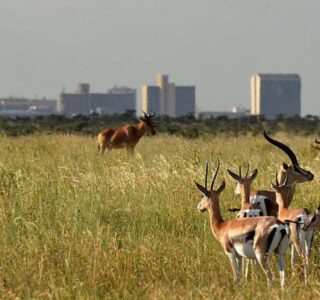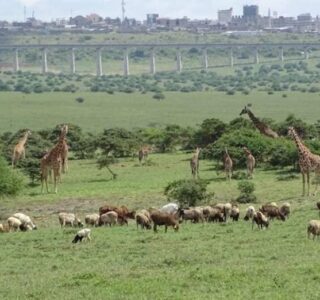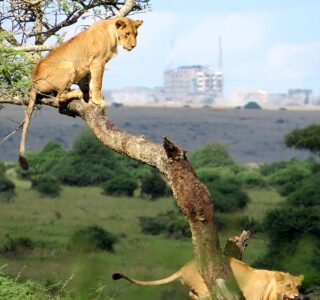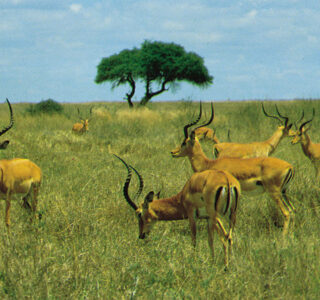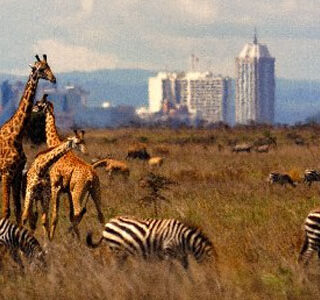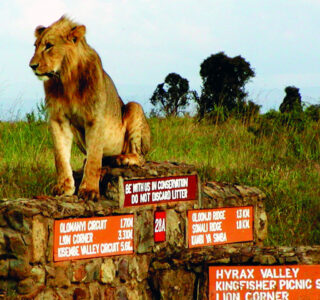“The World’s only Wildlife Capital”
The only city centre national park in the world
The oldest of Kenya’s National Parks, the first National Park to be established in East Africa and the jewel in the crown of Kenya’s wildlife tourism portfolio, Nairobi National Park is unique. No other capital city in the world can boast a natural wilderness park, teeming with wildlife and home to over 400 species of birds – just ten minutes from the city centre.
Kenya Safari Fact File
Altitude: 1,540 -1,780 meters above sea level.
Area: 117 sq km.
Location: Nairobi District, Nairobi Province.
Distance from Nairobi City Centre: 8 km from the centre of Nairobi, Kenya’s capital city.
Gazetted: Gazetted in 1945, opened December 1946.
Climate: January-March, hot and dry. April-June, hot and wet. July-October, very warm and dry. November and December warm and wet.
Vegetation: The Park has three main zones: forest at the western end, riverine forest to the south and grassy plains over much of the Park.
Wildlife: Over 100 recorded species of wildlife biodiversity to include rhino, buffalo, lion, leopard, crocodile and hippo (no elephant).
Birds: More than 400 recorded species.
Roads: The road network is well maintained, efficiently signed and can be used by 2WD vehicles all year round. Some sections may require 4WD during the rains.
Special features: The Nairobi Safari Walk, The Animal Orphanage, The Kifaru Ark shop and The Wildlife Conservation Education Centre (including a library and museum).
The Park also offers two restaurants, Sebastian’s Safari Walk Café and Rangers Restaurant (overlooking a floodlit waterhole).
Lion-gold plains, dappled shade and cool valleys
A long, sloping plain of black cotton soil scored by deep river valleys and gorges, Nairobi National Park is an area of unexpected beauty and diverse habitats, which include rolling grassy plains, riverine woodland, dense thicket, man-made dams and pools, rocky gorges and dry upland forest.
A thriving rhino sanctuary
One of Kenya’s most successful rhino sanctuaries, the Park has the highest density of black rhinos in the country.
A birding paradise
The Park’s exceptional birdlife records a remarkable 400 species; their numbers swelled March-May by a host of European migrants.
Pick of the picnic sites
Minutes from the city centre, easily accessed, and offering a well maintained and clearly signposted road network, the Park makes an ideal day trip wildlife safari venue and abounds in specially created picnic spots. These include:
Impala Observation Point and picnic site (Junction 23B)
High on a hill minutes from the main gate, this site offers a stone-built rondavel with panoramic views and a picnic area (with shaded picnic benches and latrines). It is also an excellent spot from which to scan the park for safari wildlife.
The Ivory Burning Site (Junction 1A)
Immediately inside the main gate, this area marks the spot where, in 1989, former president, Daniel Arap Moi, set fire to 12 tons of stockpiled ivory then worth over USD$ 1 million in a bid to eliminate the mass slaughter of Africa’s elephants. An important icon of wildlife protection, this popular picnic offers a broad area of open grass, picnic tables, shade and latrines.
Kingfisher Picnic Site (Junction 27C )
A cool, green shaded area with picnic tables, this is an ideal site for early morning bush breakfasts, lunchtime relaxation or evening sundowners.
Mokoyeti Picnic Site (Junction 14B)
An open cliff-top site with thatch-roof shaded picnic tables, latrines and extensive parking, this is an ideal site for family picnics at any time of the day.
Leopard Cliff Observation Point (junction 15)
A simple clearing reached by a minor diversion from the main road that leads through the Park to Cheetah Gate, this observation point offers fine panoramas of African wildlife as well as a small lookout with vistas into the rocky gorge below. Note: there are no picnic benches, shaded areas or latrines at this site.
The Hippo Pools and Nature Trail (Junction 12)
In the east of the Park, amid the meandering coils of the Athi river, lie the hippo pools, an important site for wildlife conservation. Here groups of hippo wallow in the river, emerging to graze the riverbanks at night. Terrapin and Nile crocodile bask on the exposed mud banks and the surrounding woodland features vervet monkey and Defassa waterbuck. Immediately adjacent to the hippo pools is a spacious shaded picnic area with running water, latrines and a shaded rondavel picnic site. Shaded benches also punctuate the short self-guided nature trail, which is permanently patrolled by KWS rangers and leads out of the picnic area to follow a 1km (20 minute) circuit along the river. Note visitors must vacate the hippo pools area by 5.15pm.
Nairobi Safari Walk and the Animal Orphanage
The Safari Walk (immediately to the right of the main gate) offers the rare chance of viewing captive animals behaving as they would in their natural habitat. Traversed by panoramic raised timbered boardwalks this unique wildlife park also makes for an informative walk and an enjoyable family outing.
Open: Daily 8.00am to 6.00pm including public holidays.
Note: the Safari Walk stands outside the main gates of the National Park and entry is payable by separate fees (cash in the form of Kshs or US$ is acceptable and SmartCards are not required).
The Mini Animal Orphanage
Just inside the Park (immediately to the left of the Main Gate) and very popular with families, the wildlife sanctuary of the animal orphanage is a small enclosure which shelters a shifting population of orphaned, abandoned or wounded animals; including Mara the leopard, who has been bred in captivity and is now KWS’s best-loved ambassador.
Note: the Animal Orphanage is open 8.00 am to 6.00 pm daily, stands directly within the main gates and is accessed on foot. Entry is payable by separate fees (cash in the form of Kshs or US$ is acceptable and Smart Cards are not required).
